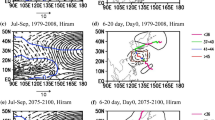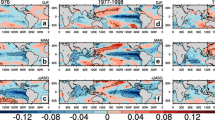Abstract
This study aims to understand the mechanisms which cause an overall reduction of SH extratropical cyclone activity with a slight increase in the high latitudes in a warmer climate simulated in general circulation models (GCMs) with increasing CO2. For this purpose, we conducted idealized model experiments by forcing warm temperature anomalies to the areas where climate change models exhibit local maximum warming—the tropics in the upper troposphere and the polar regions in the lower troposphere—simultaneously and separately. The Melbourne University atmospheric GCM (R21) coupled with prescribed SST was utilized for the experiments. Our results demonstrate that the reduction of SH extratropical cyclone frequency and depth in the midlatitudes but the slight increase in the high latitudes suggested in climate change models result essentially from the tropical upper tropospheric warming. With this tropical warming, the enhanced static stability which decreases baroclinicity in the low and midlatitudes turns out to be a major contributor to the decrease of cyclone activity equatorward of 45°S whereas the increased meridional temperature gradient in the high latitudes seems an important mechanism for the increase of cyclone activity over 50°–60°S.













Similar content being viewed by others
References
Bengtsson L, Hodges KI, Roeckner E (2006) Storm tracks and climate change. J Climate 19:3518–3543
Berbery EH, Vera CS (1996) Characteristics of the SH winter storm track with filtered and unfiltered data. J Atmos Sci 53:468–481
Boer GJ (1993) Climate change and the regulation of the surface moisture and energy budgets. Climate Dyn 8:225–239
Carnell RE, Senior CA (1998) Changes in mid-latitude variability due to increasing greenhouse gases and sulphate aerosols. Climate Dyn 14:369–383
Charney JG (1947) The dynamics of long waves in a baroclinic westerly current. J Meteor 4:135–162
Eady ET (1949) Long waves and cyclone waves. Tellus 1:33–52
Fyfe JC (2003) Extratropical Southern Hemisphere cyclones: Harbingers of climate change? J Climate 16:2802–2805
Geng Q, Sugi M (2003) Possible change of extratropical cyclone activity due to enhanced greenhouse gases and sulfate aerosols-study with a high-resolution AGCM. J Climate 16:2262–2274
Green JSA (1960) A problem in baroclinic stability. Q J R Meteor Soc 86:237–251
Hall NMJ, Hoskins BJ, Valdes PJ, Senior CA (1994) Storm tracks in a high-resolution GCM with doubled carbon dioxide. Q J R Meteor Soc 120:1209–1230
Held IM, Soden BJ (2006) Robust responses of the hydrological cycle to global warming. J Climate 19:5686–5699
Houghton JT, Ding Y, Griggs DJ, Noguer M, van der Linden PJ, Dai X, Maskell K, Johnson CA (2001) Climate Change 2001, the scientific basis. Cambridge University Press, London, 881 pp
Jung T, Gulev SK, Rudeva I, Soloviov V (2006) Sensitivity of extratropical cyclone characteristics to horizontal resolution in the ECMWF model. Q J R Meteor Soc 132:1839–1857
Keable M, Simmonds I, Keay K (2002) Distribution and temporal variability of 500 hPa cyclone characteristics in the Southern Hemisphere. Int J Climatol 22:131–150
Knippertz P, Ulbrich U, Speth P (2000) Changing cyclones and surface wind speeds over the North Atlantic and Europe in a transient GHG experiment. Climate Res 15:109–122
Lambert SJ, Fyfe J (2006) Changes in winter cyclone frequencies and strengths simulated in enhanced greenhouse warming experiments: Results from the models participating in the IPCC diagnostic exercise. Climate Dyn 26:713–728
Lim E-P, Simmonds I (2007) Southern Hemisphere winter extratropical cyclone characteristics and vertical organization observed with the ERA-40 reanalysis data in 1979–2001. J Climate 20:2675–2690
Lunkeit F, Fraedrich K, Bauer SE (1998) Storm tracks in a warmer climate: sensitivity studies with a simplified global circulation model. Climate Dyn 14:813–826
Meehl GA, Stocker TF, Collins WD, Friedlingstein P, Gaye AT, Gregory JM, Kitoh A, Knutti R, Murphy JM, Noda A, Raper SCB, Watterson IG, Weaver AJ, Zhao Z-C (2007) Global climate projections, in climate change 2007: the scientific basis: contribution of working group I to the fourth assessment report of the intergovernmental panel on climate change. In: Solomon S, Qin D, Manning M, Chen Z, Marquis M, Averyt KB, Tignor M, Miller HL (eds) Cambridge Univ Press, Cambridge, pp 747–845
Murphy BF, Pettré P, Simmonds I (2002) Effects of changing baroclinicity on the Southern Hemisphere extratropical circulation. Q J R Meteor Soc 128:1807–1826
Murray RJ, Simmonds I (1991a) A numerical scheme for tracking cyclone centres from digital data. Part I: development and operation of the scheme. Aust Meteor Mag 39:155–166
Murray RJ, Simmonds I (1991b) A numerical scheme for tracking cyclone centres from digital data. Part II: application to January and July GCM simulations. Aust Meteor Mag 39:167–180
Nielsen JW, Dole RM (1992) A survey of extratropical cyclone characteristics during GALE. Mon Weather Rev 120:1156–1167
Noone D, Simmonds I (2002) Associations between δ18O of water and climate parameters in a simulation of atmospheric circulation for 1979–95. J Climate 15:3150–3169
Pedlosky J (1987) Geophysical fluid dynamics. Springer, Berlin, 710 pp
Pierrehumbert RT (1984) Local and global baroclinic instability of zonally varying flow. J Atmos Sci 41:2141–2162
Schubert M, Perlwitz J, Blender R, Fraedrich K, Lunkeit F (1998) North Atlantic cyclones in CO2-induced warm climate simulations: frequency, intensity and tracks. Climate Dyn 14:827–837
Simmonds I (1985) Analysis of the “spinup” of a general circulation model. J Geophys Res 90:5637–5660
Simmonds I (2000) Size changes over the life of sea level cyclones in the NCEP reanalysis. Mon Weather Rev 128:4118–4125
Simmonds I, Keay K (2000a) Mean Southern Hemisphere extratropical cyclone behavior in the 40-year NCEP-NCAR reanalysis. J Climate 13:873–885
Simmonds I, Keay K (2000b) Variability of Southern Hemisphere extratropical cyclone behavior, 1958–97. J Climate 13:550–561
Simmonds I, Murray RJ (1999) Southern extratropical cyclone behavior in ECMWF analyses during the FROST special observing periods. Weather Forecast 14:878–891
Simmonds I, Murray RJ, Leighton RM (1999) A refinement of cyclone tracking methods with data from FROST. Aust Meteor Mag June:35–49
Sinclair MR, Watterson IG (1999) Objective assessment of extratropical weather systems in simulated climates. J Climate 12:3467–3485
Simmonds I, Keay K, Lim E-P (2003) Synoptic activity in the seas around Antarctica. Mon Weather Rev 131:272–288
Watterson IG (2006) The intensity of precipitation during extratropical cyclones in global warming simulations: a link to cyclone intensity? Tellus 58A:82–97
Yin JH (2005) A consistent poleward shift of the storm tracks in simulations of 21st century climate. Geophys Res Lett 32:L18701. doi:10.1029/2005GL023684
Zhang Y, Wang W-C (1997) Model-simulated northern winter cyclone and anticyclone activity under a greenhouse warming scenario. J Climate 10:1616–1634
Acknowledgments
Parts of this research was made possible by funding from the Australian Research Council, the Antarctic Science Advisory Committee and the David Lachlan Hay Memorial Fund at The University of Melbourne. The authors are grateful for the input from Xingren Wu and the Antarctic CRC and for the help with running the MUGCM experiments from Richard Wardle. Neville Nicholls, Alexandre Pezza, Harun Rashid and two anonymous reviewers are thanked for giving useful comments on the text. We appreciate the help with the IPCC figure from Julie Arblaster and programing assistance from Kevin Keay.
Author information
Authors and Affiliations
Corresponding author
Rights and permissions
About this article
Cite this article
Lim, EP., Simmonds, I. Effect of tropospheric temperature change on the zonal mean circulation and SH winter extratropical cyclones. Clim Dyn 33, 19–32 (2009). https://doi.org/10.1007/s00382-008-0444-0
Received:
Accepted:
Published:
Issue Date:
DOI: https://doi.org/10.1007/s00382-008-0444-0




